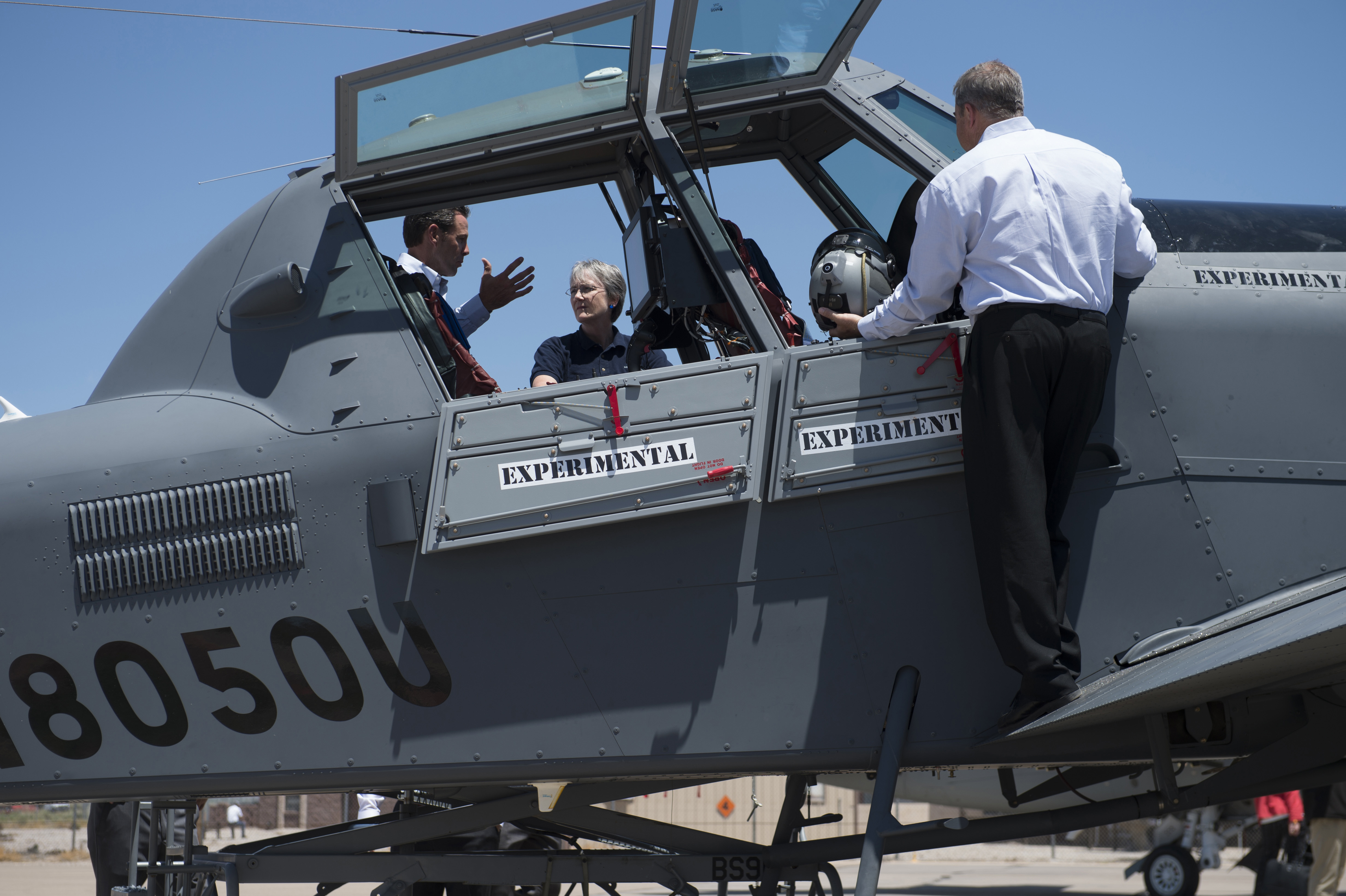
Secretary of the Air Force Heather Wilson meets with members from the Light Attack Experiment at Holloman Air Force Base, N.M., Aug. 9, 2017. USAF photo by A1C Alexis Docherty.
In order to field new capabilities rapidly, USAF may have to resort to throwing assets away rather than trying to sustain them for long periods of time, Air Force Materiel Command Chief Gen. Ellen Pawlikowski speculated Wednesday.
Speaking at an AFA Mitchell Institute event in Arlington, Va., Pawlikowski acknowledged that Advanced Concept Technology Demonstrators, which yielded capabilities like the Predator and Global Hawk remotely piloted aircraft, were fielded so quickly that their logistics trains were built almost as an afterthought, causing persistent parts and support problems.
“There will always be challenges with trying to establish a supply chain that’s going to be available for 20-30 years,” she said. “But when I talk about a rapid prototyping approach, maybe when I field it, I field it in small numbers and I don’t keep it as long.” That’s “one way to avoid this supply chain” problem.
Pawlikowski added that few people have the same cell phone they owned in 2002; typically discarding a phone when the new operating system won’t work with it. “So I think we have to think about, when we look at that supply chain piece … how long do we really plan to keep these things?” She asserted that USAF may have to “go to more of a model that accepts that we’re going to throw things away after they’re not supportable. And that will be okay, because we’ve got the next thing coming out.”
She added that while this hasn’t been worked out yet, “my suspicion is … the business case will be there” for USAF “leveraging … the newest part as opposed to trying to keep things operating by going back and getting older parts.”
The notion of keeping things in the inventory for a limited time is “one of the dialogs right now on this light attack experiment. … What does that construct look like
Pawlikowski lauded the experiment as “a great success” and “our first attempt on that scale” to try bringing an off-the-shelf asset into the service quickly.
The service’s Light Attack Experiment, known originally as OA-X, will kick off its second phase at Holloman AFB, N.M., this year. It will evaluate two aircraft, Textron Aviation’s AT-6 Wolverine and the Sierra Nevada/Embraer A-29 Super Tucano, for a possible purchase to fly close air support missions in permissive environments. The overall goal is to have a cheaper aircraft flying missions targeting violent extremism, and free up fighter aircraft to be ready for high-end missions in contested environments.
Pawlikowski noted that the experiment is not just about pilots, but includes munitions and maintainers trying things out and talking, operator to operator, with the potential suppliers. Though the first phase took six months to accomplish, she said, it took a year “to get the decision to do it,” something the Air Force “will have to work on.”
After “another year of experimentation,” Pawlikowski said the next challenge will be shepherding it across “the valley of death,” that awkward period where a successful experiment is hard to transition to a program of record because the potential user hasn’t stated a requirement for it and the Joint Requirements Oversight Council hasn’t blessed it. She doesn’t think it will be as hard to make that happen as with other successful experiments, but she noted that the earliest point at which program money could have been requested was fiscal year 2019, and it wasn’t ready by then. So “the next chance is to put it in ‘20,” she said, “three years after the experiment,” highlighting yet another difficulty of accelerating the procurement system. And then, there will be “color of money” issues of how it is paid for, whether from science and technology or research and development accounts, or from other mechanisms.
The Air Force has $2.4 billion in its five-year future years defense program to buy this fleet. Air Force Secretary Heather Wilson, speaking Wednesday at a House Appropriations Defense Subcommittee hearing, said the service could reprogram funds after the experiment if it wants to buy the aircraft faster.
In addition to the Air Force fleet, Wilson said the experiment is “coalition at the core” and it wants allies to purchase their own fleets of the aircraft. It is all part of a strategy to deal with the prospect of continued extremism in a cost-effective way, she said.
The Air Force wants to build partner capacity to the point where this violence can “be managed in individual countries,” Air Force Chief of Staff Gen. David Goldfein said Wednesday during the same hearing. “When you think light attack, you think allies and partners. That’s the big idea.”